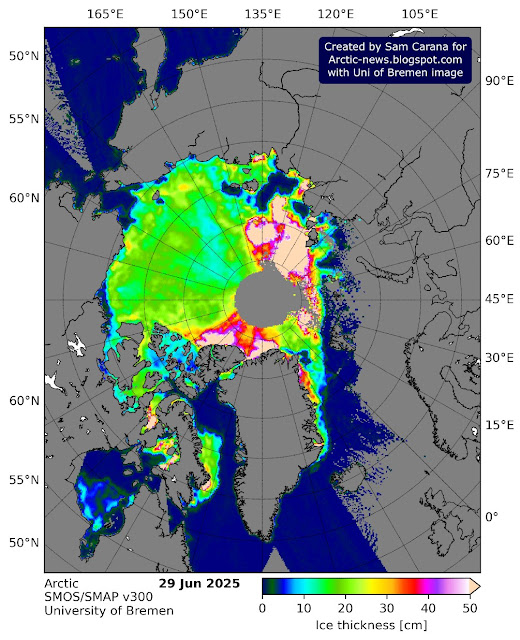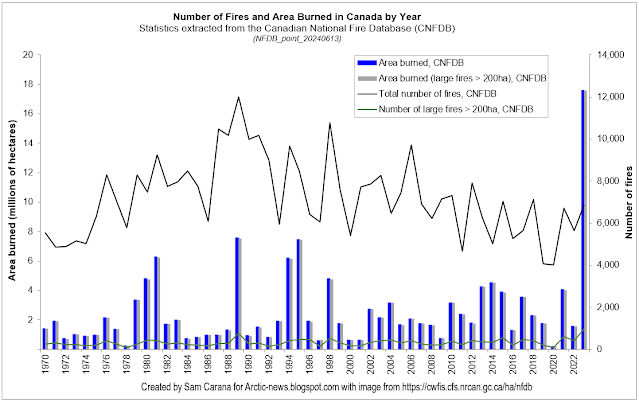Antarctic sea ice area remained at a record daily low on October 24, 2025, following a record daily low on
October 23, 2025. Antarctic sea ice area was 12.40 million km² on October 24, 2025, a deviation from 1981-2010 of -3.57σ, as illustrated by the image below.
The above image also shows that Antarctic sea ice reached a record low area of 1.09 million km² on February 24, 2023, close to a Blue Ocean Event and corresponding with a deviation of -2.86σ, i.e. smaller than the deviation of -3.57σ reached recently (on October 23, 2025).
Global sea ice extent
Low sea ice extent means that less sunlight gets reflected back into space and instead gets absorbed by the sea surface, resulting in high sea surface temperatures. Currently, sea ice is low at both poles. The low global sea ice extent at this time of year spells bad news for Antarctic sea ice, which typically reaches its minimum extent in February.
The image below shows that the standard deviation from 1981-2010 of the global sea ice extent was -6.89σ on October 31, 2025, which is remarkable given the absence of El Niño conditions in 2025.
Arctic sea ice volume
Meanwhile, Arctic sea ice volume remains at a record daily low, as it has been for more than a year. The image below shows Arctic sea ice volume through October 31, 2025.
High temperatures
Low sea ice and polar amplification of the temperature rise contribute to high air temperatures at both poles. The image below shows the September 2025 temperature anomaly compared to 1951-1980.
The low sea ice and the high temperatures are even more remarkable given the absence of El Niño conditions.
 |
| [ click on images to enlarge ] |
Little sunlight is yet reaching the South Pole at this time of year. While temperatures over Antarctica are still well below zero °C, they are rising fast. Antarctic temperature anomalies were high in September 2025 (see the above image) and in October 2025 (see the image below).
The image on the right, adapted from
NOAA, shows the ENSO outlook (CFSv2 ensemble mean, black dashed line) favors La Niña persisting into the early Northern Hemisphere winter 2025-26.
The image on the right, adapted from
ECMWF, shows the ENSO anomaly and forecast for developments in Niño3.4 through August 2026, indicating that the next El Niño will emerge and grow in strength in the course of 2026.
A record high daily Antarctic temperature was reached on October 26, 2025, corresponding with a temperature anomaly of +5.08°C versus 1979-2000, as illustrated by the image below.
The inset on the image below shows high temperature anomalies at both poles vs 1991-2020 on October 26, 2025.

A record high daily Arctic temperature was reached on October 27, 2025, corresponding with a temperature anomaly of +5.99°C versus 1979-2000, as illustrated by the image below. The inset on the image below shows high temperature anomalies at both poles vs 1991-2020 on October 27, 2025.
Global temperature anomalies have been rising over the past few months, and reached a record daily high of 15.04°C, an anomaly of +0.93°C versus 1991-2020, on October 25, 2025, as illustrated by the image below.
The following day, on October 26, 2025, the temperature reached another daily high. The image below shows temperature anomalies in red from January 1, 2023, through October 26, 2025, with a non-linear (polynomial) trend added in blue.
Note that the anomalies on the above images are calculated from 1991-2020. When calculated from pre-industrial, the anomalies will be much higher, as discussed in earlier post such as
this one.
The image below shows a forecast of the temperature anomaly vs 1981-2010 for November 2025.
The image below shows a forecast of the temperature anomaly versus 1981-2010 for December 2025.
The situation is dire. An Antarctic Blue Ocean Event (sea ice approaching a low of one million km²) threatens to occur in February 2026, triggering an Arctic Blue Ocean Event later in 2026 while the next El Niño is strengthening, which comes with a huge danger of massive amounts of methane erupting from the seafloor.
Southern Ocean sea surface getting more salty
High temperature anomalies are present at both the poles, as illustrated by the image below that shows the situation on October 25, 2025.
High temperatures come with Jet Stream distortion on October 25, 2025, as illustrated by the image below that shows the Jet Stream (at 500 hPa) moving deep over Antarctica.
This came with high precipitable water anomalies over Antarctica, as illustrated by the image below.
This came with snowfall over Antarctica, as illustrated by the image below.
The danger has been discussed in earlier posts such as
this one. The increased snowfall thickens the snow on Antarctica with only little freshwater returning to the ocean. As a result, the Southern Ocean surface is getting more salty, and as also discussed in an
earlier post, saltier surface waters sink more readily, allowing heat from the deep to rise, which can melt Antarctic sea ice from below, even during winter, making it harder for ice to reform. This vertical circulation also draws up more salt from deeper layers, reinforcing the cycle.
This leads to a loss of sea ice (and thus loss of albedo and latent heat buffer), as well as less heat getting transferred from the atmosphere into the Southern ocean, while more heat can be transferred from the Southern Ocean to the atmosphere.
The methane danger
The methane danger is illustrated by the image below, adapted from an image issued by NOAA October 29, 2025, showing hourly methane averages recorded at the Barrow Atmospheric Baseline Observatory (BRW), a NOAA facility located near Utqiaġvik (formerly Barrow), Alaska, at 71.32 degrees North.
Danger assessment
A state of emergency is typically declared after a disaster hits a specific area. The idea is that repairs or replacement of buildings, equipment and infrastructure can quickly restore the situation to what it previously was. Insurance companies have traditionally determined premiums for insurance policies by calculating the risk of events by their severity and probability.
However, extreme weather events can increasingly be expected to occur more frequently and important considerations are the intensity and severity at which one specific place gets hit by an event, as well as ubiquity and imminence of such events. As temperatures rise, more extreme weather events can be expected to occur with greater intensity, more frequently, over larger areas, with longer duration and to become more ubiquitous and follow each other up with increasing if not accelerating rapidity.

As the likeliness of a huge and accelerating temperature rise, the severity of its impact, and the ubiquity and the imminence with which it will strike all become more manifest—the more sobering it is to realize that a mere
3°C rise may suffice to cause human extinction.
Climate Emergency Declaration
UN secretary-general António Guterres
recently spoke about the need for “a credible global response plan to get us on track” regarding the international goal of limiting the global temperature rise. “The science demands action, the law commands it,” Guterres said, in reference to a recent international court of justice ruling. “The economics compel it and people are calling for it.”
What could be added is that the situation is dire and unacceptably dangerous, and the precautionary principle necessitates rapid, comprehensive and effective action to reduce the damage and to improve the outlook, where needed in combination with a
Climate Emergency Declaration, as described in posts such as
this 2022 post and
this one and as discussed in the
Climate Plan group.






































































